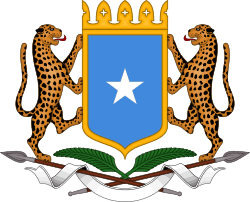Sultanate of the Geledi
The Sultanate of the Geledi (Somali: Saldanadda Geledi, Arabic: سلطنة غلدي) was a Somali kingdom that ruled parts of the Horn of Africa during the late-17th century and 19th century. The Sultanate was governed by the Gobroon Dynasty. It was established by the Geledi soldier Ibrahim Adeer, who had defeated various vassals of the Ajuran Sultanate and founded the House of Gobroon. The dynasty reached its apex under the successive reigns of Sultan Yusuf Mahamud Ibrahim, who successfully consolidated Geledi power during the Bardera wars in 1843,[1] and Sultan Ahmed Yusuf, who forced regional powers such as the Omani Empire to submit tribute. The sultanate was eventually incorporated into Italian Somaliland in 1908, and ended with the death of Osman Ahmed in 1910.[2]
Sultanate of the Geledi Saldanadda Geledi سلالة غوبرون | |||||||||
|---|---|---|---|---|---|---|---|---|---|
| late 17th century–1910 | |||||||||
| Capital | Afgooye | ||||||||
| Common languages | Somali · Arabic | ||||||||
| Religion | |||||||||
| Government | Monarchy | ||||||||
| Sulṭān Imam Sheikh | |||||||||
• late 17th century–mid 18th century | Ibrahim Adeer | ||||||||
• 1878 – 1910 | Osman Ahmed | ||||||||
| History | |||||||||
• Established | late 17th century | ||||||||
• Disestablished | 1910 | ||||||||
| |||||||||
Origins
Part of a series on the |
|---|
| History of Somalia |
|
|
|
|
|
|
|
|
At the end of the 17th century, the Ajuran Sultanate was on its decline, and various vassals were now breaking free or being absorbed by new Somali powers. One of these powers was the Silcis Sultanate, which began consolidating its rule over the Afgooye region. Ibrahim Adeer led the revolt against the Silcis ruler Umar Abrone and his oppressive daughter, Princess Fay.[3] After his victory over the Silcis, Ibrahim then proclaimed himself Sultan and subsequently started the Gobroon Dynasty.
Geledi Sultanate was a Rahanweyn Kingdom ruled by the noble Geledi clan which controlled the entire Jubba River and extending parts of Shebelle River and dominating the East African trade. The Geledi Sultanate had enough power to force the southern Arabians to pay tribute to the noble Geledi Rulers like Ahmed Yusuf (Gobroon).[4]
Military
The Geledi army numbered 20,000 men in times of peace, and could be raised to 50,000 troops in times of war.[5] The supreme commanders of the army were the Sultan and his brother, who in turn had Malaakhs and Garads under them. The military was supplied with rifles and cannons by Somali traders of the coastal regions that controlled the East African arms trade.
Rulers
Rulers of the Sultanate of the Geledi:
| # | Sultan | Reign | Notes |
|---|---|---|---|
| 1 | Ibrahim Adeer | late 17th century–mid 18th century | Established the Geledi sultanate in the late 17th century. First ruler in the Gobroon Dynasty. |
| 2 | Mahamud Ibrahim | mid-18th-1828[6] | Inherited throne from father. Bequeathed it to son. |
| 3 | Yusuf Mahamud Ibrahim | 1828–1848[6] | Rule marked the start of the golden age of the Geledis. |
| 4 | Ahmed Yusuf | 1848–1878[6] | Exacted tribute from the Omani king in the coastal town of Lamu by force and dominted the east African trade. He was able to defeat and free other East African Sultanates ruled by the Zanzibar Sultanate. |
| 5 | Osman Ahmed | 1878-1910[6] | Inherited throne from father. Reign marked the beginning of the decline of the Geledi sultanate. |
See also
- Ajuran Sultanate
- Walashma dynasty
- History of Somalia
- List of Sunni Muslim dynasties
Notes
- Historical Dictionary of Somalia. p. xxix. Retrieved 2014-02-15.
- Historical Dictionary of Somalia. p. 210. Retrieved 2014-02-15.
- Luling (1993), p.13.
- Luling (2002), p.272.
- Transactions of the Bombay Geographical Society ..by Bombay Geographical Society pg.392
- Historical Dictionary of Somalia. p. 26. Retrieved 2014-02-15.
References
- Luling, Virginia (2002). Somali Sultanate: the Geledi city-state over 150 years. Transaction Publishers. ISBN 0-7658-0914-1.
- Luling, Virginia (1993). The Use of the Past: Variation in Historical traditions in a South Somalia community. University of Besançon.
Further reading
- Virginia Luling (2002). Somali Sultanate: the Geledi city-state over 150 years. Transaction Publishers. ISBN 0-7658-0914-1.
